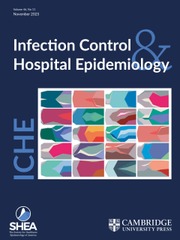Crossref Citations
This article has been cited by the following publications. This list is generated based on data provided by Crossref.
Smith, Philip W.
and
Rusnak, Patricia G.
1997.
Infection prevention and control in the long-term-care facility.
American Journal of Infection Control,
Vol. 25,
Issue. 6,
p.
488.
Dumay, M.F.
and
Macrez, A.
1997.
Organisation des soins, motivation, information et formation du personnel soignant : effets attendus.
Réanimation Urgences,
Vol. 6,
Issue. 2,
p.
237.
Smith, Philip W.
Bennett, Gail
Bradley, Suzanne
Drinka, Paul
Lautenbach, Ebbing
Marx, James
Mody, Lona
Nicolle, Lindsay
and
Stevenson, Kurt
2008.
SHEA/APIC Guideline: Infection prevention and control in the long-term care facility.
American Journal of Infection Control,
Vol. 36,
Issue. 7,
p.
504.

